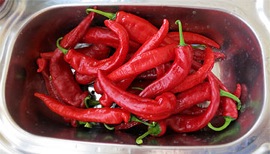 Yet again it looks like the spice is right as recent research suggests an incredibly wide scope in health benefits associated with the consumption of hot chile peppers. Not only do many varieties of fresh chiles contain considerable amounts of fiber, antioxidants, and vitamin A, B1, B2, B3, C, and E, it’s also been found that capsaicin (the active chemical component responsible for the fire in chilies) contributes positively to human health on its own.
Yet again it looks like the spice is right as recent research suggests an incredibly wide scope in health benefits associated with the consumption of hot chile peppers. Not only do many varieties of fresh chiles contain considerable amounts of fiber, antioxidants, and vitamin A, B1, B2, B3, C, and E, it’s also been found that capsaicin (the active chemical component responsible for the fire in chilies) contributes positively to human health on its own.
Specifically, when capsaicin frequently binds to receptors within the human central nervous system’s TRPV1 channel (the sensory receptor system for pain and heat detection), these receptors deplete and this depletion results in a whole host of benefits for the central nervous system at large, including terminating cancer cells, increasing the metabolic rate and digestive efficiency, increasing circulatory blood flow, and combatting inflammation, and making you feel better about the world. In other words, it looks like there’s something in the human central nervous system that an educated chili head might call an Endo-Capsaicin Receptor system (a system designed to sense and process capsaicin that, when activated, can have significant effects on the central nervous system at large) and that when this system is frequently activated by the digestion of capsaicin, we see all kinds of health benefits.
Fighting Cancer Cells
Research suggests that capsaicin can terminate cancer cells without affecting surrounding cells or nearby tissue. It looks like capsaicin is able to pull this off by instructing the mitochondria in cancer cells to undergo apoptosis, cell suicide.
Increasing Metabolism and Digestive Efficiency
Other research suggests that capsaicin causes the stomach’s epithelial cells to secrete more gastric mucus, the glycoprotein which lubricates food masses and facilitates their movement throughout the stomach. This lubrication of gastro-movement increases digestive efficiency. When it binds to the TRPV1 channel’s receptors for heat, capsaicin (which in fact isn’t hot enough to burn any bodily tissue; the burn is a sensory illusion) increases the metabolic rate by conducting thermogenesis in the body, increasing energy/calorie expenditure.
Combating inflammation
According to the JNCI, Capsaicin blocks the activation of nuclear transcription factors in the cells’ nuclei that, when activated by exogenous or endogenous free radicals or toxins, cause inflammation throughout the stomach and body.
Keep in mind we need a lot more research to substantiate all of this, but by its very nature, falsifiable empirical inquiry is limited in scope for the same reason it’s so reliable, and it’s not the only thing we have to go by as we navigate through our lives. There’s also an undeniable feel-based approach to life, a kind of folk science where personal experimentation and verification by introspection are the guiding principles, the kind of thing that lead cultures throughout the globe to be so enthralled by hot chilies since they were discovered in the New World. People who often eat hot chilies report to feeling elevated and healthy, and I’m certainly one of them. Trying heating up your own life and you’ll see what I mean.
Live hot.
Mr. Fuzz
A hot sauce maker, record producer, and writer
www.nuclearnectar.com
Latest posts by Mark Masker (see all)
- 2024 Scovie Awards Call for Entries - 07/07/2023
- 2024 Scovie Awards Early Bird Special: 3 Days Left - 06/29/2023
- 2024 Scovie Awards Early Bird Deadline Looms - 06/25/2023






